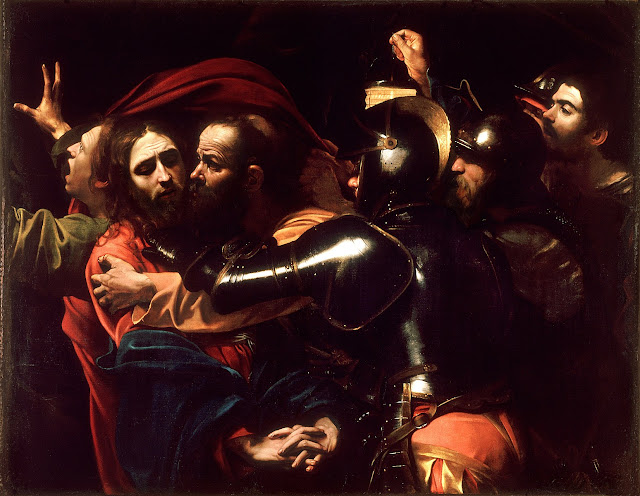The Taking of Christ by Caravaggio (Interpretation and Analysis)
 |
| The Taking of Christ Source: Wikimedia Commons |
While he was still speaking, Judas, one of the Twelve, arrived. With him was a large crowd armed with swords and clubs, sent from the chief priests and the elders of the people. Now the betrayer had arranged a signal with them: “The one I kiss is the man; arrest him.” Going at once to Jesus, Judas said, “Greetings, Rabbi!” and kissed him. Jesus replied, “Do what you came for, friend.” Then the men stepped forward, seized Jesus and arrested him.In The Taking of Christ, Caravaggio captures the moment that Judas kisses Christ. To the left, Saint John cries out in alarm while the soldiers come from the right to arrest Jesus. On the far right side of the canvas, a man—perhaps representing Saint Peter—holds a lantern aloft, illuminating the scene. This man also happens to be a self-portrait of Caravaggio; some scholars have argued that the lantern he carries is a symbol of the light of Christ, which allows the people of Caravaggio’s age to understand Jesus’ death and resurrection more clearly than Christ’s contemporaries could. In any case, the man with Caravaggio’s face is certainly the only calm figure in the painting, watching as Christ’s arrest plays out in front of him.
- Matthew 26:47-50
The rest of the painting, however, is a dynamic, visually engaging piece of art. Like all of Caravaggio’s paintings, the painting uses light and shadow—a technique known as tenebrism—to create tension and energy in the painting. Caravaggio’s dramatic composition also creates a sense of emotional upheaval. As he does in many of his paintings, the artist captures an authentic and realistic sense of chaos and emotional upheaval. Looking at the painting, the viewer is with Jesus in the Garden of Gethsemane; it is a remarkable piece of art.
While The Taking of Christ is undoubtably a masterpiece, it is most probably most famous for being missing for over two hundred years. The painting disappeared toward the end of the eighteenth century and was rediscovered—somewhat miraculously—in 1990 in the residence of the Society of Jesus, a Jesuit order, in Dublin, Ireland. For nearly one hundred years, the Jesuits had believed that the painting was a copy of Caravaggio’s missing masterpiece. However, when a conservator from the National Gallery of Ireland visited the house after being asked to restore some of the order’s paintings, it was quickly recognized as the original. If you’re interested in the full story of how the painting was lost and rediscovered, I recommend reading Jonathan Harr’s excellent book The Lost Painting, which goes into all the fascinating details.
Today, The Taking of Christ is displayed in the National Gallery of Ireland, where it remains a lasting testament to Caravaggio’s artistic skills and the power of dramatic paintings.



Comments
Post a Comment